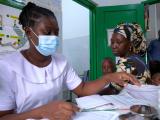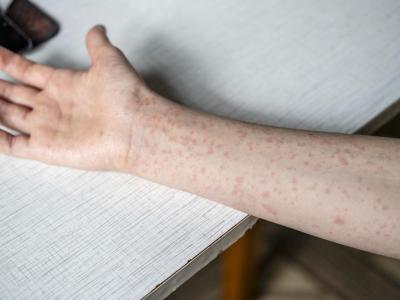Oct 6, 2011
Iowa woman's miscarriage linked to Listeria from cantaloupe
An Iowa woman with listeriosis has suffered a miscarriage that may have been caused by tainted cantaloupe. The woman, who state health officials would only identify as between 18 and 40 and from northwestern Iowa, was pregnant at the time she became ill and subsequently suffered a miscarriage, according to an Iowa Department of Public Health (IDPH) news release yesterday. "My understanding was that this played a substantial role in the miscarriage," said IDPH medical examiner Dr. Patricia Quinlisk, according to MSNBC. The case is the first reported in that state that may be linked to an outbreak traced to Jensen Farms cantaloupe, grown in Colorado, that has sickened 200 people and killed 18 in 20 states. Iowa in not listed on Jensen Farms' cantaloupe distribution list. The US Centers for Disease Control and Prevention (CDC) said the woman's case is one of three infections in pregnant women, according to MSNBC. The other two women are still pregnant and being monitored. The Des Moines Register today, citing state health officials, said the Iowa woman's illness was caused by the outbreak strain but not yet confirmed as tied to the outbreak.
Oct 5 IDPH news release
Oct 5 MSNBC story
Finland to compensate pandemic vaccine narcolepsy patients
Finland's government and an insurance company group announced yesterday that they would team up to pay for the lifetime medical care of children who experienced narcolepsy after receiving the 2009 H1N1 vaccine, Agence France-Presse (AFP) reported. The Finnish Pharmaceutical Insurance Pool (LVP) said it would honor all related claims and review each one individually to gauge the payout amount, and the Finnish government said it would cover medical costs that exceed the insurance amounts. Meanwhile, Finnish news service YLE reported yesterday that 92 people have contacted the LVP about narcolepsy symptoms and requested compensation. On Sep 1 a final report from Finnish officials confirmed the link between the 2009 H1N1 Pandemrix vaccine and narcolepsy cases and said as of late August they had received 98 reports of narcolepsy in people who had received it, most of them children.
Oct 5 AFP story
Oct 5 YLE story
Sep 1 CIDRAP News story
Chinese H5N1 cases strongly linked to live-bird markets
Chinese and US researchers found that H5N1 avian flu viruses isolated from infected people in China were highly similar genetically to isolates from the live-poultry markets they frequented, according to a story yesterday in the Journal of Virology. The team of scientists sequenced 31 H5N1 isolates from human cases from 2005 through 2010 in China and found a number of genotypes, not all of which were similar to known avian isolates. They then used patient questionnaire data to obtain environmental samples from live-poultry markets and homes frequented by six of those case-patients in 2008 and 2009 before they became infected. In each case, the environmental genetic sequences closely matched the corresponding human isolates. The researchers conclude, "Infection control measures in live poultry markets are likely to reduce human H5N1 infection in China."
Oct 5 J Virol abstract
Study: Indoor spraying of insecticide reduces malaria transmission
Spraying the insecticide bendiocarb indoors has dramatically decreased malaria transmission in many parts of Benin, which would be good news for several African countries in which resistance to another insecticide is increasing, according to a study in the American Journal of Tropical Medicine and Hygiene. Scientists evaluated the effects of two applications of bendiocarb in homes throughout the West African country over 8 months in 2009. They found that after applying insecticide on walls where mosquitoes are likely to land, none of the 350,000 household members living in the homes sustained infected bites from the malaria-carrying mosquito Anopheles gambiae. In addition, none of the mosquitoes collected from the treated homes tested positive for the malarial parasite Plasmodium falciparum. "Our success in drastically reducing malaria transmission by spraying homes with bendiocarb, which is not a pyrethroid, is very important because pyrethroid-resistance is emerging not just in Benin but also in Kenya, Niger, Nigeria, Mali, Cameroon and many other African countries," Gil Germain Padonou, MSc, a medical entomologist and study co-author said in a press release today from the American Society of Tropical Medicine and Hygiene (ASTMH), which publishes the journal.
October Am J Trop Med Hyg abstract
Oct 6 ASTMH press release
Novavax lands $1.3 million award for FMD vaccine development
Novavax, Inc, of Rockville, Md., announced yesterday that it has been awarded a $1.3 million contract from the US Department of Homeland Security to develop a virus-like-particle (VLP) vaccine to protect against foot-and-mouth disease (FMD), a potential threat to US agriculture. Novavax said in a release that it will use the funds over two and a half years to develop a VLP vaccine that, unlike current FMD vaccines, would not require using infectious FMD viruses. "We welcome this opportunity to apply our recombinant vaccine technology to address a major threat to U.S. livestock producers," said Novavax President and CEO Stanley C. Erck in the release. "Although the United States remains free of FMD, an effective vaccine will help prevent the spread of disease if an outbreak should occur."
Oct 5 Novavax news release


















